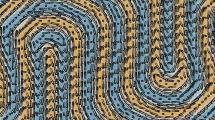Abstract.
In a recent letter (Europhys. Lett. 80, 26001 (2007)), we have shown that a compensated cholesteric liquid crystal (in which the macroscopic helix completely unwinds) may be subjected to a thermomechanical torque (the so-called Lehmann effect), in agreement with previous findings of Éber and Jánossy (Mol. Cryst. Liq. Cryst. Lett. 72, 233 (1982)). These results prove that one must take into account the chirality of the molecules and the absence of inversion symmetry at the macroscopic scale when deriving the constitutive equations of the phase at the compensation temperature. In this paper, we present the details of our experimental work and a new experiment performed in a sample treated for planar gliding anchoring. The latter experiment, coupled with a numerical simulation, supports the existence of a thermomechanical coupling in a compensated cholesteric.
Similar content being viewed by others
References
P.-G. de Gennes, J. Prost, The Physics of Liquid Crystals (Oxford University Press, Oxford, 1995).
P. Oswald, P. Pieranski, Nematic and Cholesteric Liquid Crystals: Concepts and Physical Properties Illustrated by Experiments (Taylor & Francis, CRC press, Boca Raton, 2005).
O. Lehmann, Ann. Phys. (Leipzig) 2, 649 (1900).
O. Lehmann, Flüssige Kristalle und ihr Scheinbares Leben (Verlag von Leopold Voss, Leipzig, 1921).
F.M. Leslie, Proc. R. Soc. London, Ser. A 307, 359 (1968).
N. Éber, I. Jánossy, Mol. Cryst. Liq. Cryst. Lett. 72, 233 (1982).
N. Éber, I. Jánossy, Mol. Cryst. Liq. Cryst. Lett. 102, 311 (1984).
H. Pleiner, H.R. Brand, Mol. Cryst. Liq. Cryst. Lett. 5, 61 (1987).
H. Pleiner, H.R. Brand, Mol. Cryst. Liq. Cryst. Lett. 5, 183 (1988).
N. Éber, I. Jánossy, Mol. Cryst. Liq. Cryst. Lett. 5, 81 (1988).
A. Dequidt, P. Oswald, Europhys. Lett. 80, 26001 (2007).
P. Oswald, J. Baudry, S. Pirkl, Phys. Rep. 337, 67 (2000).
F.J. Kahn, Appl. Phys. Lett. 22, 386 (1973).
P. Oswald, P.M. Moulin, P. Metz, J.-C. Géminard, P. Sotta, J. Phys. III 3, 1891 (1993).
K.C. Lim, J.T. Ho, Mol. Cryst. Liq. Cryst. 47, 173 (1978).
As pointed out by Pawel Pieranski, convection must develop in the sample as long as it is submitted to a horizontal temperature gradient. As a result, the director field must distort in homeotropic samples because of the shear flow. It can be checked that this effect should lead to a phase shift $\Phi_{\ab{H}}$ proportional to $d^9$. This dependence is very different from that observed experimentally ($\Phi_{\ab{H}}\propto d^5$), suggesting that hydrodynamic effects are negligible in our experiments. This conclusion agrees with the experimental results of Éber and Jánossy eber1 who found that $\Phi_{\ab{H}}= 0$ at all temperature gradients in a pure nematic (8CB).
We emphasize that in the planar geometry the convection does not destabilize the director field as the director is perpendicular to the shear plane.
S.W. Morris, P. Palffy-Muhoray, D.A. Balzarini, Mol. Cryst. Liq. Cryst. 139, 263 (1986).
C.V. Brown, N.J. Mottram, Phys. Rev. E 68, 031702 (2003).
A. Dequidt, P. Oswald, Eur. Phys. J. E 24, 157 (2007).
E.P. Raynes, Mol. Cryst. Liq. Cryst. Lett. 4, 1 (1986).
D. Taupin, Probabilities Data Reduction and Error Analysis in the Physical Sciences (Les Editions de Physique, Les Ulis, 1988).
Note that we have implicitly assumed that $\nu_{eff}$ is positive as in the mixture 8CB+CC, for which this result was proved experimentally by Éber and Jánossy in reference eber2. We emphasize that taking $\nu_{eff}<0$ would have lead to $\nu=-10.4\times10^{-7}$kg K^-1 s^-2, which is more than three times larger in absolute value than the retained value. The conclusion is that, in all cases, $\nu$ is different from 0, which is the main result of this article.
I. Dozov, D.N. Stoenescu, S. Lamarque-Forget, Ph. Martinot-Lagarde, E. Polossat, Appl. Phys. Lett. 77, 4124 (2000).
C. Blanc, D. Svensek, S. Zumer, M. Nobili, Phys. Rev. Lett. 95, 097802 (2005).
N.V. Madhusudana, R. Pratibha, H.P. Padmini, Mol. Cryst. Liq. Cryst. 202, 35 (1991).
H.P. Padmini, N.V. Madhusudana, Liq. Cryst. 14, 497 (1993).
Author information
Authors and Affiliations
Corresponding author
Rights and permissions
About this article
Cite this article
Dequidt, A., Żywociński, A. & Oswald, P. Lehmann effect in a compensated cholesteric liquid crystal: Experimental evidence with fixed and gliding boundary conditions. Eur. Phys. J. E 25, 277–289 (2008). https://doi.org/10.1140/epje/i2007-10290-4
Received:
Accepted:
Published:
Issue Date:
DOI: https://doi.org/10.1140/epje/i2007-10290-4




